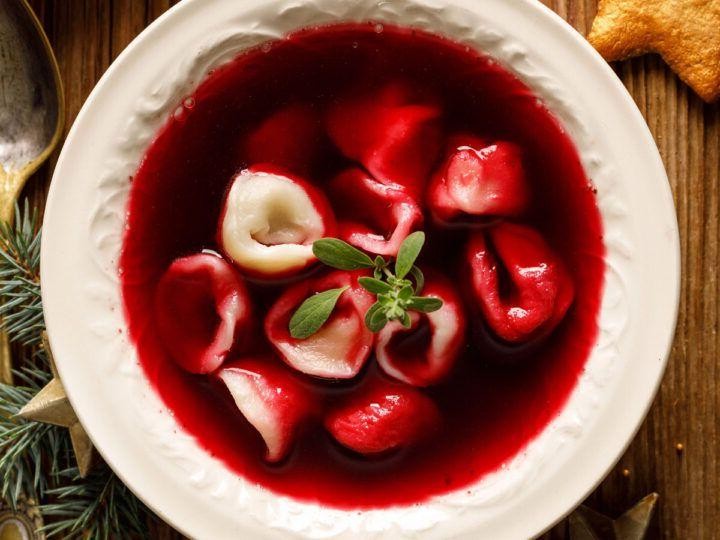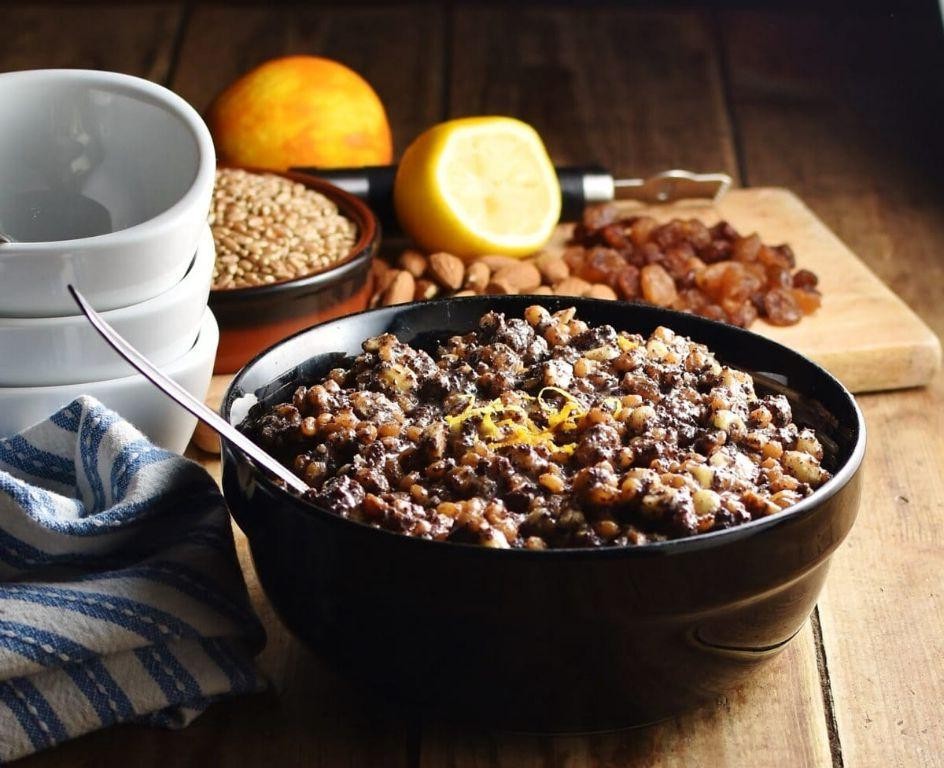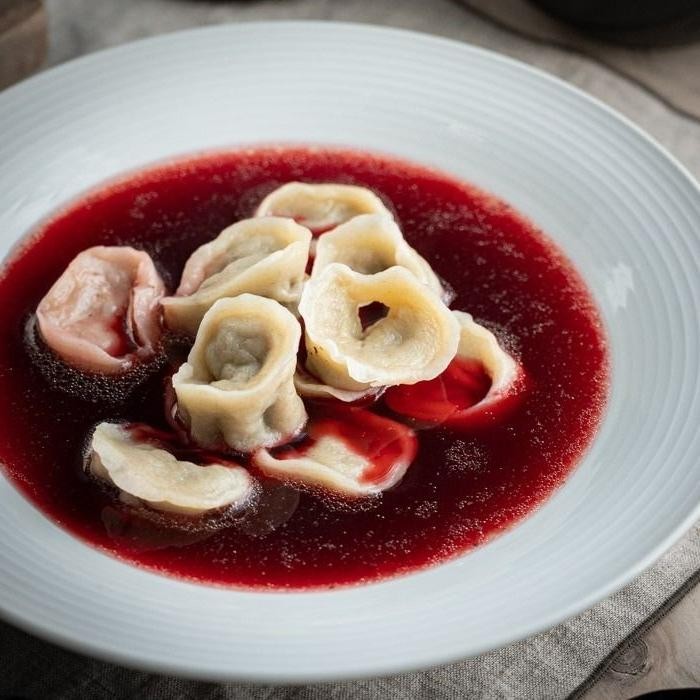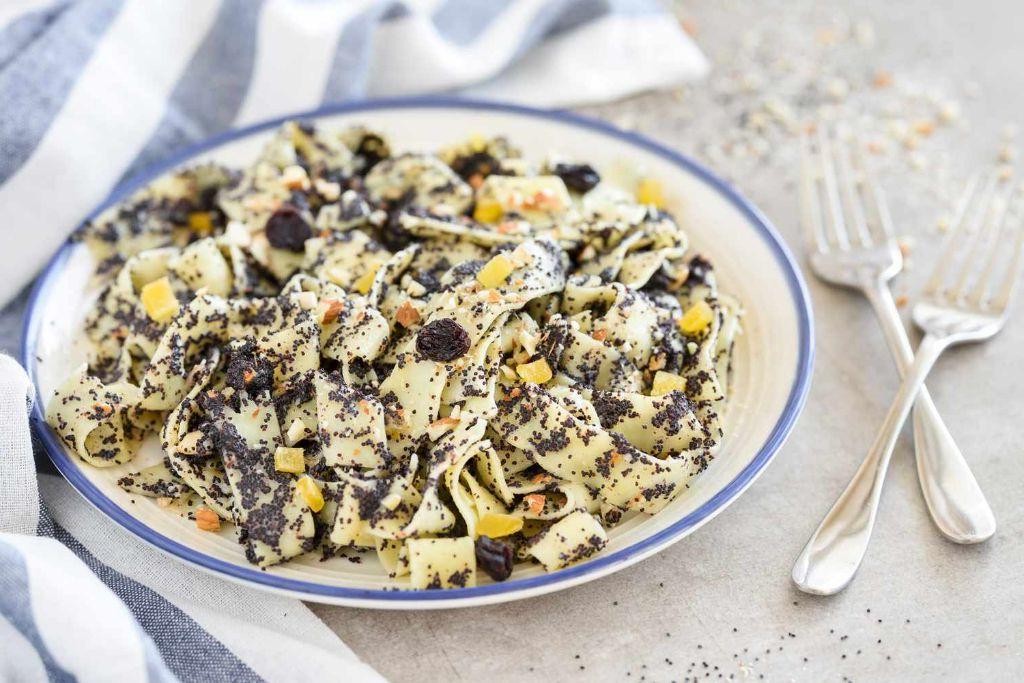Step into the magical world of Polish Christmas traditions with these 34 delightful recipes that transform holiday meals into unforgettable feasts. From golden pierogi to honey-spiced cookies, these authentic dishes bring generations of family warmth to your table. Let’s explore these cherished flavors and create your own Christmas memories—each recipe is a delicious story waiting to be shared!
Pierogi with Sauerkraut and Mushrooms

Gently, as autumn settles in, I find myself drawn to the kitchen, where the simple act of folding dough around earthy fillings feels like wrapping comfort in a soft embrace. There’s something deeply soothing about crafting pierogi, each one a little pocket of warmth, especially when filled with tangy sauerkraut and savory mushrooms. It’s a quiet ritual that slows the world down, if only for an afternoon.
Ingredients
For the dough, you’ll need about 2 cups of all-purpose flour, a couple of large eggs, a splash of water (around 1/4 cup), and a pinch of salt. For the filling, grab a cup of drained sauerkraut, a generous handful of chopped mushrooms (about 1 cup), half a finely diced onion, a tablespoon of butter, and a sprinkle of salt and pepper.
Instructions
1. In a large bowl, combine 2 cups of all-purpose flour and a pinch of salt. 2. Crack 2 large eggs into the flour mixture and stir gently with a fork. 3. Slowly add 1/4 cup of water, mixing until a shaggy dough forms. 4. Knead the dough on a floured surface for about 5 minutes until it becomes smooth and elastic. 5. Cover the dough with a damp cloth and let it rest for 30 minutes at room temperature. 6. While the dough rests, melt 1 tablespoon of butter in a skillet over medium heat. 7. Add half a diced onion and sauté for 4–5 minutes until translucent and fragrant. 8. Stir in 1 cup of chopped mushrooms and cook for another 6–8 minutes until they release their moisture and turn golden brown. 9. Mix in 1 cup of drained sauerkraut and a sprinkle of salt and pepper, cooking for 3–4 more minutes to blend the flavors, then remove from heat to cool. 10. Roll out the rested dough on a floured surface to about 1/8-inch thickness. 11. Use a 3-inch round cutter or glass to cut circles from the dough. 12. Place a heaping teaspoon of the cooled filling in the center of each dough circle. 13. Fold the dough over the filling to form a half-moon shape, pressing the edges firmly to seal. 14. Bring a large pot of salted water to a rolling boil over high heat. 15. Carefully drop the pierogi into the boiling water in batches, cooking for 3–4 minutes until they float to the surface. 16. Remove the pierogi with a slotted spoon and let them drain briefly. 17. For a crispy finish, heat a skillet with a bit of butter over medium-high heat and pan-fry the boiled pierogi for 2–3 minutes per side until golden brown. Buttery and rich, these pierogi offer a delightful contrast between the tender, chewy dough and the savory, tangy filling that melts with each bite. Serve them warm with a dollop of sour cream or alongside a simple salad for a meal that feels both rustic and refined.
Bigos Stew with Kielbasa

Remembering how the crisp autumn air used to carry the scent of woodsmoke and simmering pots from my grandmother’s kitchen, I find myself drawn back to those comforting flavors today, wanting to recreate that sense of warmth and belonging in my own home. There’s something deeply soothing about letting ingredients slowly meld together, transforming simple components into something rich and complex over hours of gentle cooking. This bigos stew feels like wrapping yourself in a culinary hug, each ingredient adding its own story to the pot.
Ingredients
– A couple of tablespoons of olive oil
– One large yellow onion, chopped
– Three cloves of garlic, minced
– One pound of kielbasa sausage, sliced into half-inch rounds
– One pound of pork shoulder, cut into one-inch cubes
– A generous splash of red wine (about half a cup)
– Two cups of beef broth
– One 14.5-ounce can of sauerkraut, drained
– One tablespoon of tomato paste
– Two bay leaves
– A teaspoon of caraway seeds
– A couple of teaspoons of paprika
– Salt and freshly ground black pepper
Instructions
1. Heat two tablespoons of olive oil in a large Dutch oven over medium heat until it shimmers.
2. Add the chopped onion and cook for 5-7 minutes, stirring occasionally, until translucent and fragrant.
3. Stir in the minced garlic and cook for exactly 1 minute until aromatic but not browned.
4. Add the sliced kielbasa and cook for 4-5 minutes, turning occasionally, until lightly browned on both sides.
5. Transfer the kielbasa and onions to a clean plate using a slotted spoon, leaving the rendered fat in the pot.
6. Season the pork cubes generously with salt and pepper before adding to the hot pot.
7. Brown the pork on all sides for 6-8 minutes, developing a deep golden crust without crowding the pan.
8. Tip: Working in batches ensures proper browning and prevents steaming.
9. Return the kielbasa and onions to the pot with the browned pork.
10. Pour in the half cup of red wine, scraping the bottom of the pot to release all the browned bits.
11. Let the wine reduce by half, about 3-4 minutes of active simmering.
12. Stir in the tomato paste and cook for 1 minute to deepen its flavor.
13. Add the drained sauerkraut, beef broth, bay leaves, caraway seeds, and paprika.
14. Tip: Rinsing the sauerkraut lightly reduces acidity while keeping its characteristic tang.
15. Bring the stew to a gentle boil, then immediately reduce heat to the lowest setting.
16. Cover the pot and simmer for 2 hours, stirring occasionally to prevent sticking.
17. Tip: The long, slow cooking allows the flavors to fully develop and the pork to become fork-tender.
18. After 2 hours, remove the lid and continue simmering uncovered for 30 minutes to thicken the sauce.
19. Remove the bay leaves and season with additional salt and pepper if needed.
20. Let the stew rest off heat for 15 minutes before serving to allow the flavors to settle.
Mellowed by hours of gentle simmering, the pork becomes impossibly tender while the sauerkraut softens into the rich broth, creating a beautiful balance between tangy and savory notes. The kielbasa adds smoky depth that permeates every bite, making this stew even more flavorful the next day as the ingredients continue to harmonize. I love serving it in deep bowls with thick slices of dark rye bread for dipping, or sometimes spooned over mashed potatoes for the ultimate comfort meal.
Barszcz Wigilijny (Christmas Eve Borscht)

Lately, I’ve been thinking about how certain foods hold entire histories in their flavors, like this crimson broth that appears on Polish tables only once a year, carrying generations of Christmas Eve memories in its earthy sweetness.
Ingredients
– 4 medium red beets, peeled and chopped
– 1 medium yellow onion, diced
– 2 cloves garlic, minced
– 6 cups vegetable broth
– 2 tablespoons white vinegar
– 1 bay leaf
– A couple of whole allspice berries
– A splash of lemon juice
– A small handful of fresh dill, chopped
– 1 teaspoon sugar
– A pinch of salt
– A dollop of sour cream for serving
Instructions
1. Place the chopped beets, diced onion, and minced garlic in a large pot.
2. Pour the 6 cups of vegetable broth over the vegetables until they’re fully submerged.
3. Add the bay leaf and whole allspice berries to the pot.
4. Bring the mixture to a boil over high heat, then immediately reduce to a gentle simmer.
5. Cover the pot and let it simmer for 45 minutes until the beets are completely tender when pierced with a fork.
6. Remove the pot from heat and carefully take out the bay leaf and allspice berries using a slotted spoon.
7. Stir in the 2 tablespoons of white vinegar and a splash of lemon juice.
8. Add the 1 teaspoon of sugar and a pinch of salt, stirring until dissolved.
9. Let the borscht cool for 15 minutes before blending to prevent splattering.
10. Use an immersion blender to puree the soup until completely smooth, or transfer to a countertop blender in batches.
11. Stir in the chopped fresh dill just before serving.
12. Ladle the borscht into bowls and top each with a dollop of sour cream.
Our borscht settles into a velvety texture that carries both the earthiness of beets and the bright sharpness of vinegar. The sour cream melts into pink swirls that temper the soup’s vibrant acidity, making each spoonful feel like unwrapping a gift. Sometimes I serve it in small glass bowls to let that jewel-toned color shine through, or with extra dill scattered across the surface like green confetti.
Makowiec (Poppy Seed Cake)

Vaguely, through the kitchen window, I watch autumn leaves drift down like forgotten memories, which makes me think of my grandmother’s makowiec—that swirled poppy seed cake that tastes like whispered stories and cinnamon-spiced afternoons.
Ingredients
– 2 cups of poppy seeds, ground
– 1 cup of milk
– ½ cup of honey
– 1 teaspoon of vanilla extract
– A splash of lemon juice
– 2 teaspoons of cinnamon
– A pinch of salt
– 4 cups of all-purpose flour
– 1 packet of active dry yeast
– ½ cup of warm water (about 110°F)
– ¼ cup of granulated sugar
– 2 large eggs
– ½ cup of unsalted butter, softened
– 1 egg yolk mixed with a tablespoon of milk for brushing
Instructions
1. In a small bowl, combine the warm water, yeast, and a teaspoon of sugar, then let it sit for 5–7 minutes until frothy.
2. In a large mixing bowl, whisk together the flour, remaining sugar, and salt.
3. Add the yeast mixture, eggs, and softened butter to the flour, then knead on a floured surface for 8–10 minutes until the dough is smooth and elastic.
4. Place the dough in a greased bowl, cover it with a damp cloth, and let it rise in a warm spot for 1–1.5 hours until doubled in size.
5. While the dough rises, simmer the poppy seeds and milk in a saucepan over medium heat for 10 minutes, stirring often to prevent sticking.
6. Remove the poppy seed mixture from heat, then stir in the honey, vanilla, lemon juice, and cinnamon until well combined; let it cool completely.
7. Tip: Chill the filling in the refrigerator for 20 minutes to make it easier to spread without tearing the dough.
8. Punch down the risen dough and roll it out on a floured surface into a 12×16-inch rectangle.
9. Evenly spread the cooled poppy seed filling over the dough, leaving a 1-inch border on all sides.
10. Tightly roll the dough from the long side, like a jelly roll, and pinch the seam to seal.
11. Transfer the roll to a baking sheet lined with parchment paper, seam-side down, and cover it loosely with the cloth.
12. Let it rise again for 45–60 minutes until puffy; preheat the oven to 350°F during the last 15 minutes.
13. Brush the top of the roll with the egg yolk mixture for a golden finish.
14. Bake for 30–35 minutes, or until the top is deep golden brown and sounds hollow when tapped.
15. Tip: Rotate the baking sheet halfway through baking to ensure even browning.
16. Let the cake cool completely on a wire rack before slicing to keep the layers intact.
17. Tip: For easier slicing, use a serrated knife and gentle sawing motions.
Lightly spiced and richly textured, this cake offers a tender crumb that gives way to the nutty, honey-sweet filling—perfect with a dusting of powdered sugar or a dollop of whipped cream for a cozy treat that feels like a hug from the past.
Sernik (Polish Cheesecake)

Falling into the rhythm of autumn afternoons, I find myself craving the kind of dessert that feels like a warm embrace, something simple yet deeply comforting. This Polish cheesecake, or sernik, is exactly that—a tender, not-too-sweet slice of tradition that fills the kitchen with the gentlest aroma of vanilla and citrus. It’s the kind of treat that asks for nothing more than a quiet moment and a cup of tea.
Ingredients
– About two pounds of farmer’s cheese, at room temperature
– A stick and a half of unsalted butter, softened
– A cup and a half of granulated sugar
– Five large eggs, also at room temperature
– A generous half-cup of all-purpose flour
– A couple of teaspoons of pure vanilla extract
– The zest from one bright lemon
– A splash of whole milk, just to loosen things up
– A pinch of fine salt
Instructions
1. Preheat your oven to 350°F and generously butter a 9-inch springform pan.
2. In a large bowl, beat the softened butter and granulated sugar together with an electric mixer on medium speed for about 3 minutes, until pale and fluffy.
3. Add the farmer’s cheese and beat on low speed just until smooth, being careful not to overmix—this keeps the texture light.
4. Crack in the eggs one at a time, mixing on low after each addition until just incorporated.
5. Sprinkle in the all-purpose flour and a pinch of salt, then mix on low until no dry streaks remain.
6. Stir in the vanilla extract, lemon zest, and that splash of whole milk until the batter is uniformly combined.
7. Pour the batter into the prepared springform pan and use a spatula to smooth the top evenly.
8. Bake in the preheated oven for 50 to 60 minutes, or until the edges are golden and the center jiggles only slightly when gently shaken.
9. Turn off the oven, crack the door open, and let the cheesecake cool inside for 1 hour to prevent cracking.
10. Remove from the oven and let it cool completely on a wire rack before chilling in the refrigerator for at least 4 hours, or preferably overnight.
Gently slice into this sernik to reveal its dense, velvety crumb—each bite carries the bright whisper of lemon and the warmth of vanilla. It’s wonderful on its own, but for a little sparkle, scatter a handful of fresh berries over the top or drizzle with a thin honey glaze. However you serve it, this cake holds the quiet magic of shared stories and slow afternoons.
Kutia (Wheat Berry Pudding)

Dipping my spoon into this ancient Eastern European tradition feels like uncovering a forgotten family secret, one where each wheat berry carries generations of winter stories within its tender heart. There’s something quietly magical about how simple grains, honey, and nuts transform into a dish that feels both nourishing and nostalgic, especially as the days grow shorter and we crave warmth from within.
Ingredients
– 1 cup of wheat berries, rinsed well
– 4 cups of cold water
– a generous half-cup of wildflower honey
– a big handful of chopped walnuts
– a couple of tablespoons of poppy seeds
– a splash of vanilla extract
– a pinch of fine sea salt
Instructions
1. Rinse 1 cup of wheat berries under cool running water until the water runs clear.
2. Place the rinsed wheat berries in a medium saucepan and add 4 cups of cold water.
3. Bring the water to a rolling boil over high heat, then reduce the heat to low and cover the pan.
4. Simmer the wheat berries for 60 minutes, checking occasionally to ensure the water doesn’t completely evaporate.
5. Test a wheat berry after 60 minutes—it should be tender but still slightly chewy, with no hard center.
6. Drain any remaining water from the cooked wheat berries using a fine-mesh strainer.
7. Return the drained wheat berries to the saucepan and stir in a generous half-cup of wildflower honey while the berries are still warm.
8. Add a big handful of chopped walnuts, a couple of tablespoons of poppy seeds, a splash of vanilla extract, and a pinch of fine sea salt to the mixture.
9. Gently fold all ingredients together until the honey coats everything evenly and the poppy seeds are distributed.
10. Let the kutia sit at room temperature for 15 minutes to allow the flavors to meld together.
Maybe it’s the way the chewy wheat berries play against the crunchy walnuts, or how the honey seeps into every bite, leaving a floral sweetness that lingers. I love serving it slightly warm in small bowls, sometimes with a drizzle of extra honey or a scattering of pomegranate seeds for a burst of color and tartness that cuts through the richness.
Golabki (Stuffed Cabbage Rolls)

Evenings like these, when the air turns crisp and the light fades early, my mind drifts back to my grandmother’s kitchen, where the scent of simmering cabbage and savory filling would fill the house with a warmth that felt like a hug. Each golabki, a tender cabbage leaf wrapped snugly around a hearty filling, was a little parcel of comfort, a tradition passed down through generations that always made the world feel a little softer, a little kinder.
Ingredients
- 1 large head of green cabbage
- 1 pound of ground beef
- 1 cup of cooked white rice
- 1 small yellow onion, finely chopped
- 2 cloves of garlic, minced
- 1 large egg
- A couple of tablespoons of tomato paste
- 1 (28-ounce) can of crushed tomatoes
- A splash of beef broth, about 1/2 cup
- A pinch of salt and a few cracks of black pepper
Instructions
- Bring a large pot of water to a rolling boil over high heat.
- Carefully lower the whole head of cabbage into the boiling water and cook for 5-7 minutes, until the outer leaves are soft and pliable. (Tip: Use tongs to gently peel away the softened outer leaves as they loosen, transferring them to a plate to cool—this makes separating the leaves much easier without tearing them.)
- In a large mixing bowl, combine the ground beef, cooked white rice, finely chopped yellow onion, minced garlic, and the large egg.
- Season the mixture with a pinch of salt and a few cracks of black pepper, then mix everything together with your hands until just combined. (Tip: Avoid overmixing to keep the filling tender and light.)
- Lay one softened cabbage leaf flat on a cutting board and place about 1/4 cup of the beef and rice mixture in the center.
- Fold the sides of the leaf inward over the filling, then roll it up tightly from the bottom to form a neat bundle.
- Repeat with the remaining leaves and filling until all are used.
- Preheat your oven to 350°F.
- Spread a thin layer of the crushed tomatoes over the bottom of a 9×13-inch baking dish.
- Arrange the cabbage rolls seam-side down in a single layer in the dish.
- In a small bowl, whisk together the remaining crushed tomatoes, a couple of tablespoons of tomato paste, and a splash of beef broth until smooth.
- Pour the tomato sauce evenly over the cabbage rolls, covering them completely.
- Cover the baking dish tightly with aluminum foil and bake at 350°F for 1 hour and 15 minutes. (Tip: For extra tenderness, let them rest for 10 minutes after baking—this allows the flavors to meld and the rolls to firm up slightly.)
- Remove the foil and bake for an additional 15 minutes, until the sauce is bubbly and the tops are lightly browned.
But the true magic happens when you cut into one: the cabbage gives way with a gentle tear, revealing a steaming, savory filling that’s both robust and comforting. Serve them nestled in a shallow bowl with extra sauce spooned over the top, or alongside a slice of crusty bread to soak up every last bit of that rich, tomatoey goodness.
Karp po Zydowsku (Carp in Jewish Style)

A gentle simmering pot on a quiet afternoon always brings me back to this traditional dish, with its humble origins and comforting aromas that fill the kitchen like a warm embrace. As the fish slowly cooks with sweet carrots and earthy onions, it creates a harmony of flavors that feels both ancient and deeply personal, a recipe passed down through generations that still finds its way to my table when I need something soulful and restorative.
Ingredients
- a whole 2-pound carp, cleaned and scaled
- a couple of large yellow onions, thinly sliced
- three medium carrots, peeled and cut into thin rounds
- a quarter cup of golden raisins
- a tablespoon of honey
- a splash of white vinegar
- two cups of water
- a pinch of salt
- a few whole black peppercorns
- a bay leaf
Instructions
- Rinse the 2-pound carp under cold running water and pat it completely dry with paper towels.
- Slice the two large yellow onions thinly, aiming for uniform pieces so they cook evenly.
- Peel the three medium carrots and cut them into thin rounds, about 1/4-inch thick.
- Place the sliced onions and carrots in a large, heavy-bottomed pot or Dutch oven.
- Add the quarter cup of golden raisins, tablespoon of honey, splash of white vinegar, two cups of water, pinch of salt, few whole black peppercorns, and bay leaf to the pot.
- Bring the mixture to a boil over medium-high heat, then immediately reduce to a gentle simmer.
- Carefully place the whole carp on top of the vegetables in the pot, making sure it’s submerged in the liquid.
- Cover the pot with a tight-fitting lid and simmer for 45 minutes over low heat, avoiding any vigorous boiling that could break the fish.
- Check the carp after 45 minutes by inserting a fork near the backbone; it should flake easily and appear opaque throughout.
- Tip: If the liquid reduces too much during cooking, add another 1/4 cup of water to maintain the braising consistency.
- Using two large spatulas, carefully transfer the whole carp to a serving platter to keep it intact.
- Tip: Let the fish rest for 5 minutes before serving to allow the flavors to settle and make slicing cleaner.
- Strain the cooking liquid through a fine-mesh sieve, pressing gently on the vegetables to extract their flavor.
- Return the strained liquid to the pot and simmer for 5 more minutes to slightly thicken the sauce.
- Tip: For a smoother sauce, you can blend the cooked vegetables with a bit of the cooking liquid before straining.
- Pour the warm sauce over the carp just before serving. The fish becomes wonderfully tender, almost melting at the touch of a fork, with the sweet carrots and raisins balancing the subtle vinegar tang. This dish shines when served over creamy mashed potatoes or with crusty bread to soak up every bit of the fragrant sauce, making each bite a quiet celebration of tradition and comfort.
Uszka (Small Mushroom Dumplings)

Perhaps there’s something quietly magical about these little folded parcels, how they cradle earthy mushrooms within tender dough, carrying the warmth of Polish kitchens into our own. They feel like edible secrets, these uszka, meant to be discovered slowly, one delicate bite at a time.
Ingredients
– A couple of cups of all-purpose flour
– A splash of warm water, about ½ cup
– One large egg
– A pinch of salt
– About 2 cups of finely chopped cremini mushrooms
– One small yellow onion, diced
– A couple of tablespoons of unsalted butter
– A drizzle of olive oil, maybe 1 tablespoon
– A sprinkle of black pepper
Instructions
1. Place 2 cups of all-purpose flour in a large mixing bowl and make a well in the center.
2. Crack one large egg into the well and add ½ cup of warm water and a pinch of salt.
3. Use a fork to gradually incorporate the flour into the wet ingredients until a shaggy dough forms.
4. Knead the dough on a lightly floured surface for 8–10 minutes until it becomes smooth and elastic.
5. Wrap the dough in plastic wrap and let it rest at room temperature for 30 minutes.
6. While the dough rests, melt 2 tablespoons of unsalted butter with 1 tablespoon of olive oil in a skillet over medium heat.
7. Add one diced small yellow onion and sauté for 5–7 minutes until translucent and fragrant.
8. Stir in 2 cups of finely chopped cremini mushrooms and cook for 10–12 minutes until they release their moisture and turn golden brown.
9. Season the mushroom mixture with a sprinkle of black pepper and remove from heat to cool completely.
10. Roll out the rested dough on a floured surface to ⅛-inch thickness.
11. Cut the dough into 2-inch squares using a sharp knife or pastry wheel.
12. Place 1 teaspoon of the cooled mushroom filling in the center of each square.
13. Fold each square diagonally to form a triangle, pressing the edges firmly to seal.
14. Bring the two opposite corners of the triangle together and pinch them to create the classic uszka shape.
15. Bring a large pot of salted water to a rolling boil over high heat.
16. Gently drop the uszka into the boiling water and cook for 3–4 minutes until they float to the surface.
17. Use a slotted spoon to transfer the cooked uszka to a plate.
Delicate and tender, these little dumplings offer a satisfying chew that gives way to the savory, earthy mushroom filling. Their subtle pepper notes make them wonderful floating in clear broths or simply drizzled with melted butter and fresh herbs for a cozy appetizer.
Chrust (Polish Angel Wings Pastry)

Zipping through old recipe cards in my grandmother’s tin, I rediscovered these delicate pastries that taste like sweet whispers from another time. Their paper-thin crispness carries memories of snowy mornings and kitchen warmth, a tradition worth preserving one golden twist at a time. Making chrust feels like unfolding a delicate paper crane with your hands, each step a meditation in patience and precision.
Ingredients
– 2 cups of all-purpose flour
– 3 large egg yolks
– 1/4 cup of granulated sugar
– a splash of vanilla extract
– 1/4 cup of sour cream
– a couple of tablespoons of unsalted butter, melted
– a pinch of salt
– vegetable oil for frying
– powdered sugar for dusting
Instructions
1. In a large bowl, whisk together the 2 cups of flour and pinch of salt until well combined.
2. Add the 3 egg yolks, 1/4 cup granulated sugar, splash of vanilla extract, 1/4 cup sour cream, and melted butter to the flour mixture.
3. Mix everything with your hands until a smooth, slightly sticky dough forms, about 3-4 minutes of kneading.
4. Cover the dough tightly with plastic wrap and let it rest at room temperature for exactly 30 minutes to relax the gluten.
5. Divide the rested dough into 4 equal portions and roll each portion out on a floured surface until paper-thin, about 1/16-inch thickness.
6. Cut the rolled dough into 2-inch wide strips, then cut each strip diagonally into 4-inch long pieces.
7. Make a 1-inch slit lengthwise down the center of each piece and gently pull one end through the slit to create a twisted shape.
8. Heat 2 inches of vegetable oil in a heavy-bottomed pot to 350°F, using a candy thermometer to monitor the temperature precisely.
9. Fry 3-4 pastries at a time for about 45-60 seconds per side until they turn golden brown and puff up slightly.
10. Remove the fried pastries with a slotted spoon and drain them on a wire rack set over paper towels to prevent sogginess.
11. Let the pastries cool completely for about 15 minutes before dusting generously with powdered sugar using a fine-mesh sieve.
Varying between delicate crispness and tender flakiness, these angel wings shatter beautifully with each bite, releasing their subtle vanilla sweetness. The powdered sugar melts against the warm pastry like morning frost, perfect alongside strong black coffee or as an elegant addition to your holiday cookie platter.
Kompot z Suszu (Dried Fruit Compote)

Often, when the air turns crisp and leaves begin their slow descent, I find myself craving something that bridges summer’s brightness and winter’s warmth. This dried fruit compote, a gentle simmer of autumn’s preserved treasures, feels like sipping on softened sunlight and spiced memories. It’s the kind of quiet comfort that asks for nothing more than a cozy mug and a moment of stillness.
Ingredients
– a generous cup of mixed dried fruits (I used apricots, apples, and prunes)
– about 4 cups of cold water
– a couple of cinnamon sticks
– a splash of fresh lemon juice
– a small handful of sugar
Instructions
1. Rinse the mixed dried fruits under cool running water to remove any dust.
2. Place the rinsed fruits into a medium-sized saucepan.
3. Pour 4 cups of cold water over the fruits, ensuring they’re fully submerged.
4. Add the cinnamon sticks directly into the water.
5. Squeeze a splash of fresh lemon juice into the saucepan.
6. Sprinkle the small handful of sugar evenly over the surface.
7. Bring the mixture to a gentle boil over medium-high heat, which should take about 5-7 minutes.
8. Once boiling, immediately reduce the heat to low until maintaining a soft simmer.
9. Simmer uncovered for 25-30 minutes, until the fruits have plumped significantly and softened.
10. Remove the saucepan from heat and let it cool for at least 15 minutes to allow flavors to meld.
11. Carefully remove the cinnamon sticks using tongs.
12. Serve warm or transfer to jars for chilling.
The fruits become tender almost to melting, their sweetness deepened by the cinnamon’s warmth while the lemon keeps it from cloying. I love it poured over morning oatmeal or alongside a sharp cheese, where its gentle syrup makes everything feel like a small celebration.
Ryz z Jablkami (Rice with Apples)

Gently, as autumn leaves begin their slow descent, I find myself craving the simple comfort of my grandmother’s kitchen, where the sweet scent of apples and cinnamon would weave through the air like a warm memory. This humble dish of rice and apples was her quiet offering, a sweet, spiced rice that felt like a hug in a bowl on crisp fall afternoons. It’s a recipe that asks for little but gives so much warmth, a gentle simmer of comfort from a simpler time.
Ingredients
- A cup of long-grain white rice
- A couple of medium apples, peeled and chopped
- Two cups of whole milk
- A splash of water
- A quarter cup of granulated sugar
- A generous pinch of ground cinnamon
- A pat of unsalted butter
Instructions
- Rinse 1 cup of long-grain white rice under cold running water in a fine-mesh strainer until the water runs clear, which helps remove excess starch for fluffier rice.
- Combine the rinsed rice, 2 cups of whole milk, and a splash of water in a medium saucepan over medium heat.
- Bring the mixture to a gentle simmer, stirring occasionally to prevent sticking, then reduce the heat to low and cover the pan with a tight-fitting lid.
- Simmer the rice for 15 minutes, without lifting the lid, to allow it to steam properly and absorb the liquid.
- While the rice cooks, peel and chop 2 medium apples into ½-inch pieces, tossing them with a quarter cup of granulated sugar and a generous pinch of ground cinnamon in a bowl.
- After 15 minutes, uncover the saucepan and gently fold in the sugared apple mixture and a pat of unsalted butter until well combined.
- Cover the pan again and continue cooking over low heat for another 10 minutes, or until the apples are tender when pierced with a fork and the rice has absorbed most of the liquid.
- Remove the pan from the heat and let it sit, covered, for 5 minutes to allow the flavors to meld and any remaining liquid to be absorbed.
Here, the rice turns wonderfully creamy, each grain soft yet distinct, while the apples melt into a spiced sweetness that whispers of cinnamon and comfort. I love serving it warm in little bowls, perhaps with an extra dusting of cinnamon or a drizzle of honey for those who crave a deeper sweetness, making it a cozy treat for quiet moments.
Piernik (Polish Gingerbread)

Zigzagging through my grandmother’s recipe box this afternoon, I found her piernik card, stained with honey and cinnamon, and suddenly the whole kitchen smelled like Christmas memories. There’s something about this Polish gingerbread that feels like a warm hug from generations past, a sweet spice lingering in the air long after the baking is done.
Ingredients
– 2 cups of all-purpose flour
– 3/4 cup of dark honey
– 1/2 cup of brown sugar
– 2 large eggs
– 1/2 cup of melted butter
– 1 teaspoon of baking soda
– A generous tablespoon of ground ginger
– A couple of teaspoons of cinnamon
– A good pinch of ground cloves
– A splash of strong brewed coffee
– A handful of chopped walnuts
Instructions
1. Preheat your oven to 350°F and generously butter a 9×5 inch loaf pan.
2. In a medium saucepan over low heat, warm the honey, brown sugar, and melted butter until the sugar dissolves completely, about 3-4 minutes, stirring constantly with a wooden spoon.
3. Remove the honey mixture from heat and let it cool until it’s warm to the touch but not hot, about 10 minutes. (Tip: If the mixture is too hot, it will cook the eggs when you add them later.)
4. Whisk the eggs thoroughly in a small bowl until they’re pale and frothy.
5. Slowly pour the whisked eggs into the cooled honey mixture while stirring continuously to prevent curdling.
6. Add the splash of brewed coffee to the wet ingredients and stir until fully incorporated.
7. In a separate large bowl, whisk together the flour, baking soda, ground ginger, cinnamon, and ground cloves until well combined.
8. Gradually pour the wet ingredients into the dry ingredients, folding gently with a spatula until just combined—don’t overmix.
9. Fold in the chopped walnuts until evenly distributed throughout the batter.
10. Pour the batter into your prepared loaf pan and smooth the top with the spatula.
11. Bake for 45-50 minutes, or until a toothpick inserted into the center comes out clean with just a few moist crumbs attached. (Tip: The top will be dark brown and spring back lightly when touched when it’s done.)
12. Let the piernik cool completely in the pan on a wire rack for at least 2 hours before slicing. (Tip: This gingerbread tastes even better the next day as the flavors continue to develop and meld together.)
You’ll notice the crust gives way to a wonderfully moist, dense crumb that holds the warmth of all those spices. Yesterday I discovered it’s sublime when served slightly warm with a dollop of whipped cream, the ginger notes dancing with the sweet creaminess in a way that feels both ancient and completely new.
Kluski z Makiem (Noodles with Poppy Seeds)

Kind of like finding an old photo album in the attic, this dish brings back memories of chilly evenings and family kitchens, where simple ingredients transformed into something quietly magical. There’s something about the gentle crunch of poppy seeds against soft noodles that feels like a whispered secret from generations past, a humble comfort that asks for nothing but a quiet moment to be appreciated.
Ingredients
- A generous 8 ounces of wide egg noodles
- A full cup of finely ground poppy seeds
- Half a cup of whole milk, warmed just enough to take the chill off
- A quarter cup of unsalted butter, softened to room temperature
- A third cup of granulated sugar
- A couple of tablespoons of honey for that floral sweetness
- A tiny splash of pure vanilla extract
- A small handful of golden raisins, if you’re feeling fancy
Instructions
- Bring a large pot of salted water to a rolling boil over high heat—the water should taste like the sea, which helps season the noodles from within.
- Add the 8 ounces of wide egg noodles and cook for exactly 7-8 minutes, stirring occasionally to prevent sticking, until they’re tender but still have a slight bite.
- Drain the noodles thoroughly in a colander, then return them to the warm pot off the heat to let any residual moisture evaporate.
- In a medium bowl, combine the 1 cup of finely ground poppy seeds with the 1/2 cup of warmed whole milk, stirring until the mixture resembles a thick, fragrant paste.
- Add the 1/4 cup of softened unsalted butter, 1/3 cup of granulated sugar, 2 tablespoons of honey, and a splash of vanilla extract to the poppy seed mixture, mixing vigorously until everything is fully incorporated and glossy.
- Tip: If using raisins, plump them first by soaking in hot water for 5 minutes—this prevents them from absorbing moisture from the dish later.
- Gently fold the poppy seed mixture into the warm noodles until every strand is evenly coated, taking care not to break the noodles.
- Tip: Let the dish sit for 10 minutes before serving—this allows the flavors to meld and the poppy seeds to soften further, creating a more harmonious texture.
- If including raisins, drain and pat them dry, then sprinkle over the top just before serving for a burst of chewy sweetness.
- Tip: For extra richness, toast the poppy seeds in a dry skillet over medium heat for 2-3 minutes before grinding—this deepens their nutty flavor without bitterness.
Now the noodles cradle the poppy seeds like tiny jewels, each bite offering a subtle crunch that gives way to creamy, honey-kissed warmth. I love serving this slightly warm, maybe with a dusting of powdered sugar or alongside roasted apples for contrast—it’s the kind of quiet dessert that feels like a hug from the inside.
Conclusion
From pierogi to poppy seed rolls, these 34 traditional Polish Christmas recipes offer a wonderful way to bring authentic European flavors to your holiday table. We hope you’ll try making some of these delightful dishes, share which ones become your favorites in the comments below, and don’t forget to pin this article on Pinterest to spread the Christmas cheer!



